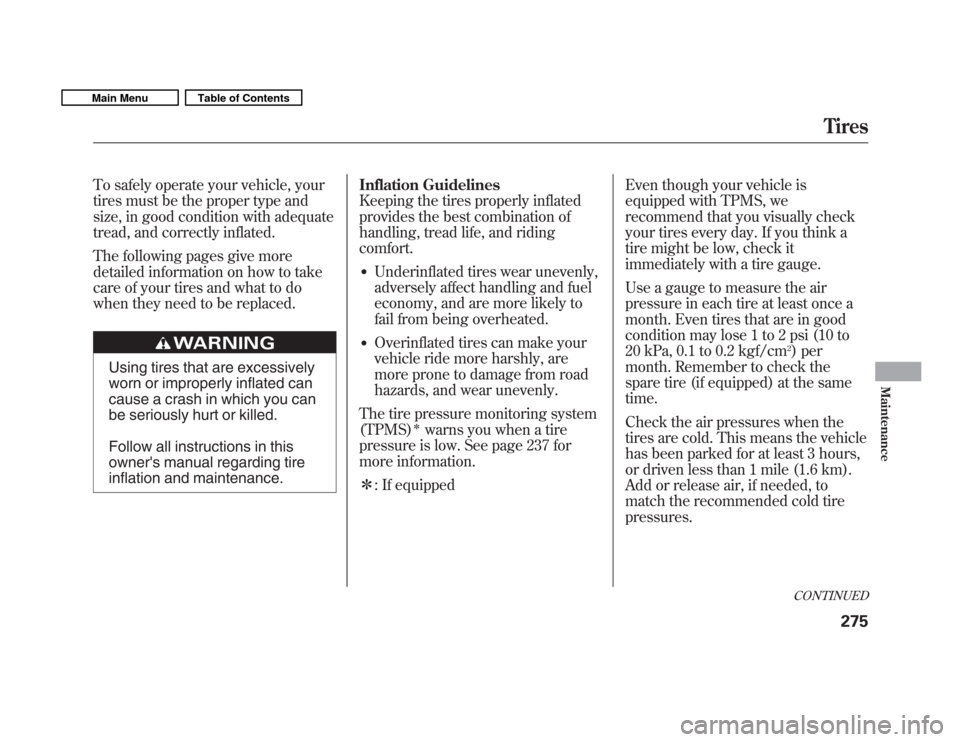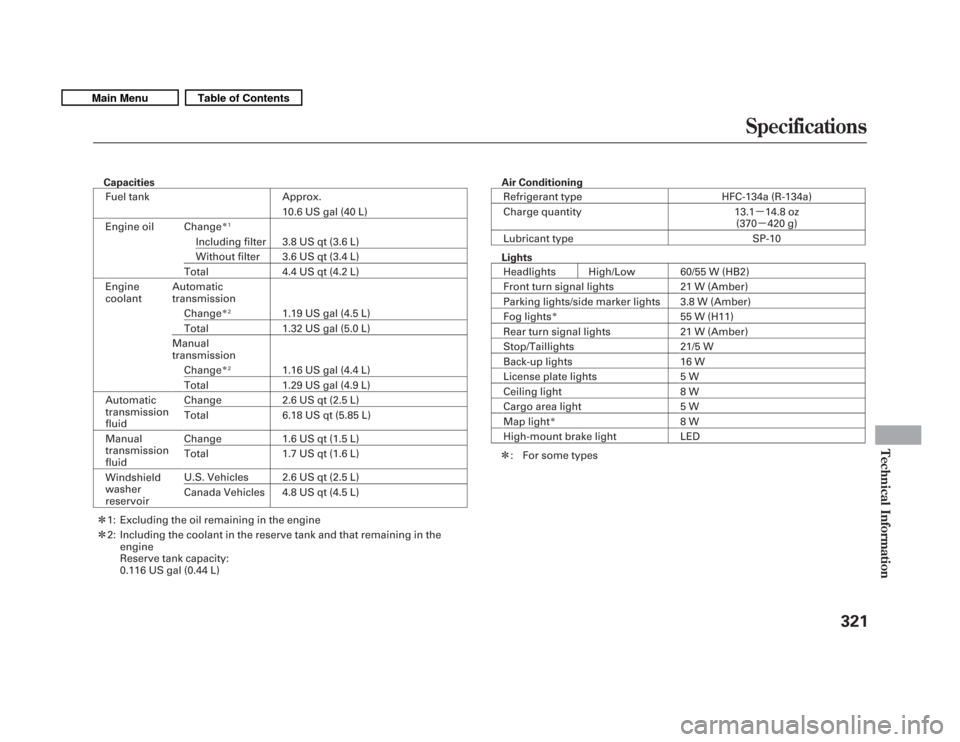Page 256 of 356

However, service at a dealer is not
mandatory to keep your warranties in
effect. Maintenance may be done by
any qualified service facility or
person who is skilled in this type of
automotive service. Make sure to
have the service facility or person
reset the display as previously
described. Keep all receipts as proof
of completion, and have the person
who does the work fill out your
Honda Service History or Canadian
Maintenance Log. Check your
warranty booklet for moreinformation.
We recommend using Honda parts
and fluids whenever you have
maintenance done. These are
manufactured to the same high
quality standards as the original
components, so you can be confident
of their performance and durability.U.S. Vehicles:
According to state and federal
regulations, failure to perform
maintenance on the items markedwith
�will not void your emissions
warranties. However, all
maintenance services should be
performed in accordance with the
intervals indicated by the informationdisplay.
Owner's Maintenance Checks
You should check the following
items at the specified intervals. If you
are unsure of how to perform any
check, turn to the appropriate pagelisted. �
Engine oil level �Check every
time you fill the fuel tank. See page204.
� Engine coolant level �Check the
radiator reserve tank every time
you fill the fuel tank. See page 204.
� Automatic transmission �Check
the fluid level monthly. See page261.
� Brakes �Check the fluid level
monthly. See page 263.
� Tires �Check the tire pressure
monthly. Examine the tread for
wear and foreign objects. See page276.
� Lights �Check the operation of
the headlights, parking lights,
taillights, high-mount brake light,
and license plate lights monthly.
See page 264.
Maintenance MinderTM
252
Main MenuTable of Contents
Page 279 of 356

To safely operate your vehicle, your
tires must be the proper type and
size, in good condition with adequate
tread, and correctly inflated.
The following pages give more
detailed information on how to take
care of your tires and what to do
when they need to be replaced.
Using tires that are excessively
worn or improperly inflated can
cause a crash in which you can
be seriously hurt or killed.
Follow all instructions in this
owner's manual regarding tire
inflation and maintenance.Inflation Guidelines
Keeping the tires properly inflated
provides the best combination of
handling, tread life, and ridingcomfort.
� Underinflated tires wear unevenly,
adversely affect handling and fuel
economy, and are more likely to
fail from being overheated.
� Overinflated tires can make your
vehicle ride more harshly, are
more prone to damage from road
hazards, and wear unevenly.
The tire pressure monitoring system (TPMS)
�warns you when a tire
pressure is low. See page 237 for
more information. � : If equipped Even though your vehicle is
equipped with TPMS, we
recommend that you visually check
your tires every day. If you think a
tire might be low, check it
immediately with a tire gauge.
Use a gauge to measure the air
pressure in each tire at least once a
month. Even tires that are in good
condition may lose 1 to 2 psi (10 to
20 kPa, 0.1 to 0.2 kgf/cm
2) per
month. Remember to check the
spare tire (if equipped) at the sametime.
Check the air pressures when the
tires are cold. This means the vehicle
has been parked for at least 3 hours,
or driven less than 1 mile (1.6 km).
Add or release air, if needed, to
match the recommended cold tirepressures.
CONTINUED
Tires
275
Maintenance
Main MenuTable of Contents
Page 325 of 356

CapacitiesFuel tank Approx.
10.6 US gal (40 L)
Engine oil Change
� 1
Including filter 3.8 US qt (3.6 L)
Without filter 3.6 US qt (3.4 L)
Total 4.4 US qt (4.2 L)
Engine
coolant Automatic
transmission
Change
�21.19 US gal (4.5 L)
Total 1.32 US gal (5.0 L)
Manual
transmission Change
�21.16 US gal (4.4 L)
Total 1.29 US gal (4.9 L)
Automatic
transmission fluid Change 2.6 US qt (2.5 L)
Total 6.18 US qt (5.85 L)
Manual
transmission fluid Change 1.6 US qt (1.5 L)
Total 1.7 US qt (1.6 L)
Windshield
washer
reservoir U.S. Vehicles 2.6 US qt (2.5 L)
Canada Vehicles 4.8 US qt (4.5 L)
� 1: Excluding the oil remaining in the engine
� 2: Including the coolant in the reserve tank and that remaining in the
engine
Reserve tank capacity:
0.116 US gal (0.44 L) Air Conditioning
Refrigerant type HFC-134a (R-134a)
Charge quantity 13.1 -14.8 oz
(370 -420 g)
Lubricant type SP-10
Lights Headlights High/Low 60/55 W (HB2)
Front turn signal lights 21 W (Amber)
Parking lights/side marker lights 3.8 W (Amber)
Fog lights
�55 W (H11)
Rear turn signal lights 21 W (Amber)
Stop/Taillights 21/5 W
Back-up lights 16 W
License plate lights 5 W
Ceiling light 8 W
Cargo area light 5 W
Map light
�8W
High-mount brake light LED
� : For some types
Specifications
321
Technical Information
Main MenuTable of Contents